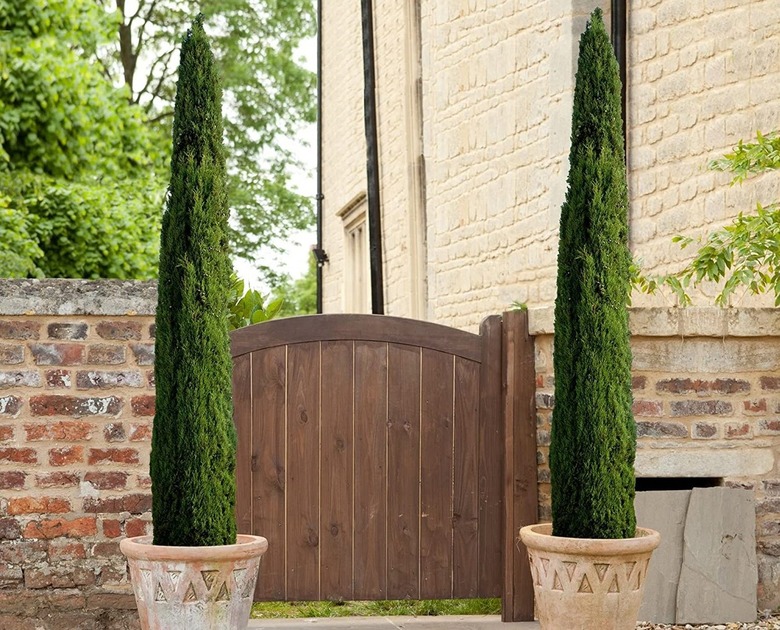How To Care For Potted Cypress Trees
We may receive a commission on purchases made from links.
What exactly is a European cypress tree? You may know it by its better-known common name, Italian cypress, or even Mediterranean cypress. These are tall, narrow evergreens that are often among the small, potted evergreens sold over the holidays for indoor Christmas trees. You can also grow them from seeds.
Although the tree may be small at the moment, it could easily grow much, much bigger if you take good care of it. As a first step, check to see whether the pot has drainage holes and if not, prepare to transplant it immediately.
Meet the Italian Cypress
Meet the Italian Cypress
Italian cypress trees (Cupressus sempervirens) are easily recognized when growing outside. They are tall, columnar evergreen trees that are dense with blue-green scalelike leaves. Tall and majestic, they are often planted in a line for a windrows or in twos on either side of an entryway. When young, these trees grow fast, but they slow down as they mature. They can grow to 110 feet tall and 10 feet wide.
There are also smaller dwarf versions of the Italian cypress, like the cultivars Cupressus sempervirens 'Dwarf' and 'Tiny Tower.' They have the same blue-green foliage and a narrow shape, but they do not get taller than 25 feet. Their spread does not exceed 3 feet, and the trees grow extremely slowly. Clearly, these are better for potted plants than the regular cypress.
Care for an Italian Cypress
Care for an Italian Cypress
Despite its common names linking it to Italy or Europe, this cypress originated in Persia, roughly modern-day Iran. Today, it can be found growing in the wild in eastern Mediterranean countries, like Greece, Turkey, and Israel. The climate in these areas is Mediterranean, with hot, dry summers and wet winters. This gives an idea of its climate and care preferences.
The Italian cypress thrives outside in U.S. Department of Agriculture plant hardiness zones 7 through 11. Italian cypress trees require full and direct sunshine and cannot grow well without it, but in other areas of cultural care, they are easy. They accept almost any type of soil, including alkaline and acidic, loamy, sand, and clay. If the soil doesn't offer excellent drainage, however, the plant may suffer from root rot. These trees, both regular and dwarf, become extremely drought-tolerant as they mature and need little if any pruning.
Understand Potted Cypress Care
Understand Potted Cypress Care
A tree planted in a container has the same basic cultural care requirements as a tree in the soil. A potted Italian cypress will still need a location that provides six hours of direct sun and excellent drainage. Make sure the potting soil drains well and that the container has sufficient drain holes to allow excess water to drip out.
The smaller amount of soil around a container-grown plant's roots generally makes irrigation more of a concern. Don't count on their drought tolerance and forgo regular irrigation but wait until the soil is dry before watering again.
Your tree will need to be repotted regularly as it grows. Each time, select a pot a few inches larger in diameter than the prior pot. If the tree is a regular-size cypress, you will probably want to plant it in the ground at some point as it gets taller. The dwarf cypress can be grown in containers outdoors. They work well as porch or patio accents used to flank a door or gate.
